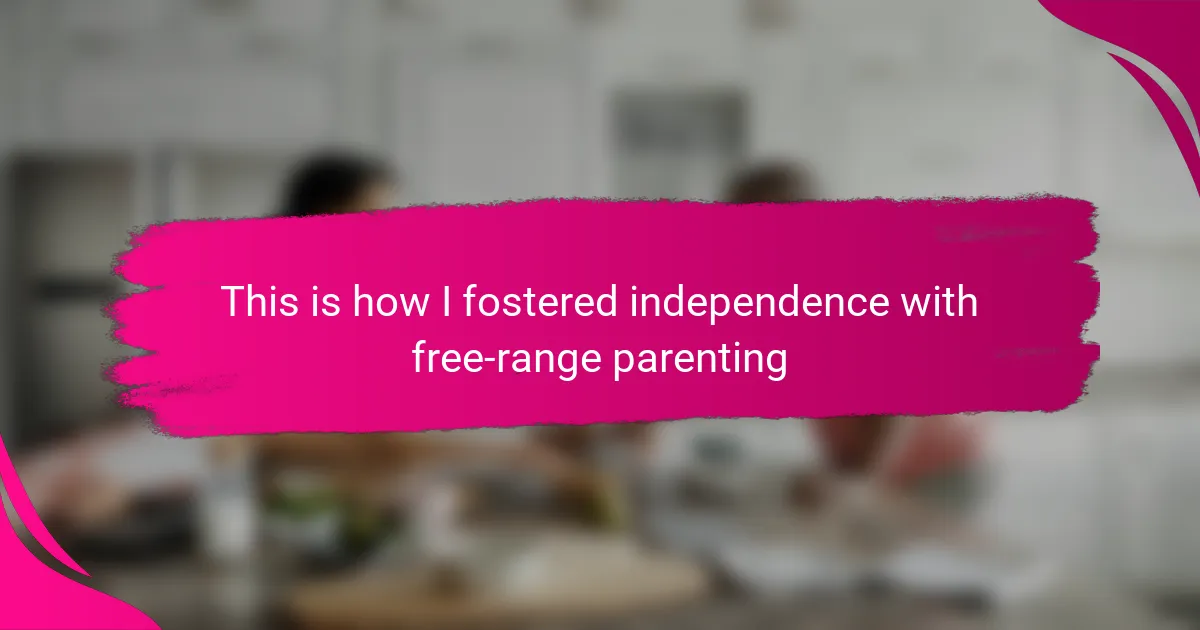Key takeaways
- Free-range parenting encourages independence by allowing children to make choices and solve problems, fostering resilience and confidence.
- Setting clear boundaries creates a safe environment for exploration while teaching kids about responsibility.
- Encouraging decision-making through age-appropriate tasks helps children build self-esteem and problem-solving skills.
- Open communication about safety and trust cultivates a balance between freedom and precaution, enhancing parent-child relationships.
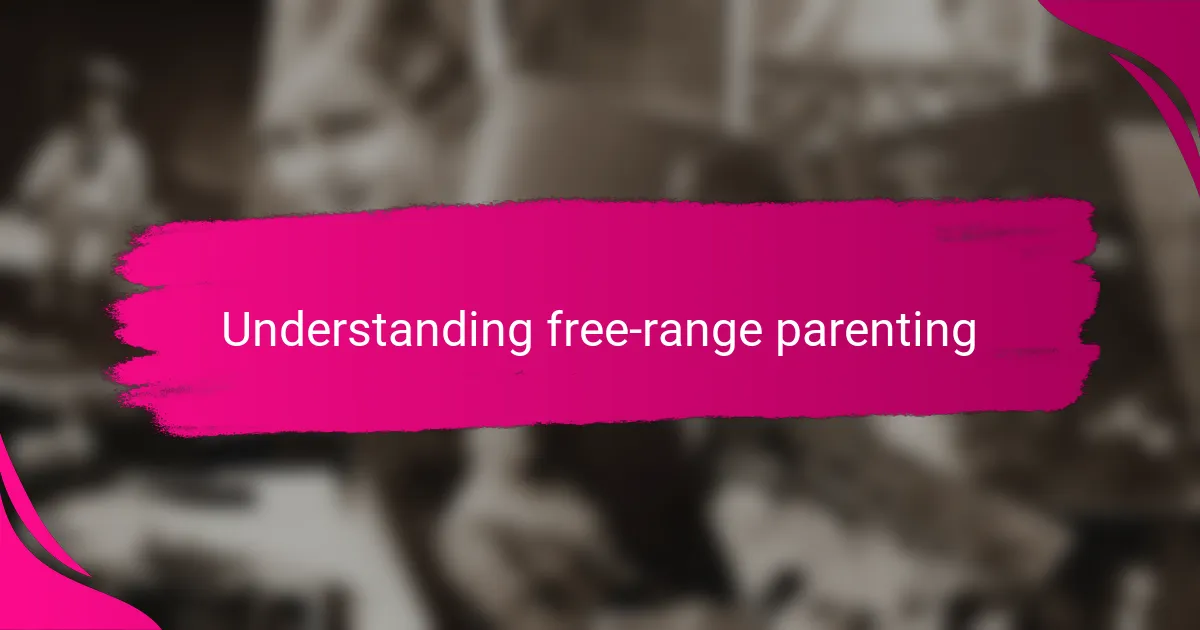
Understanding free-range parenting
Free-range parenting, to me, means trusting my children to explore their world with less hovering and more freedom. It’s about believing in their ability to make safe choices, even when it feels scary as a parent. Have you ever wondered what happens when you step back just enough to let your child take the lead?
When I first embraced free-range parenting, it was challenging to resist the urge to constantly supervise. But I noticed that giving my kids room to solve problems on their own sparked confidence I hadn’t seen before. It’s almost as if their independence grew every time I held back from jumping in.
Of course, free-range doesn’t mean neglect or letting kids roam completely unsupervised. It’s a balance — like setting clear boundaries while allowing enough space for children to learn from natural consequences. That mix, I’ve found, creates the kind of independence that feels deeply authentic.
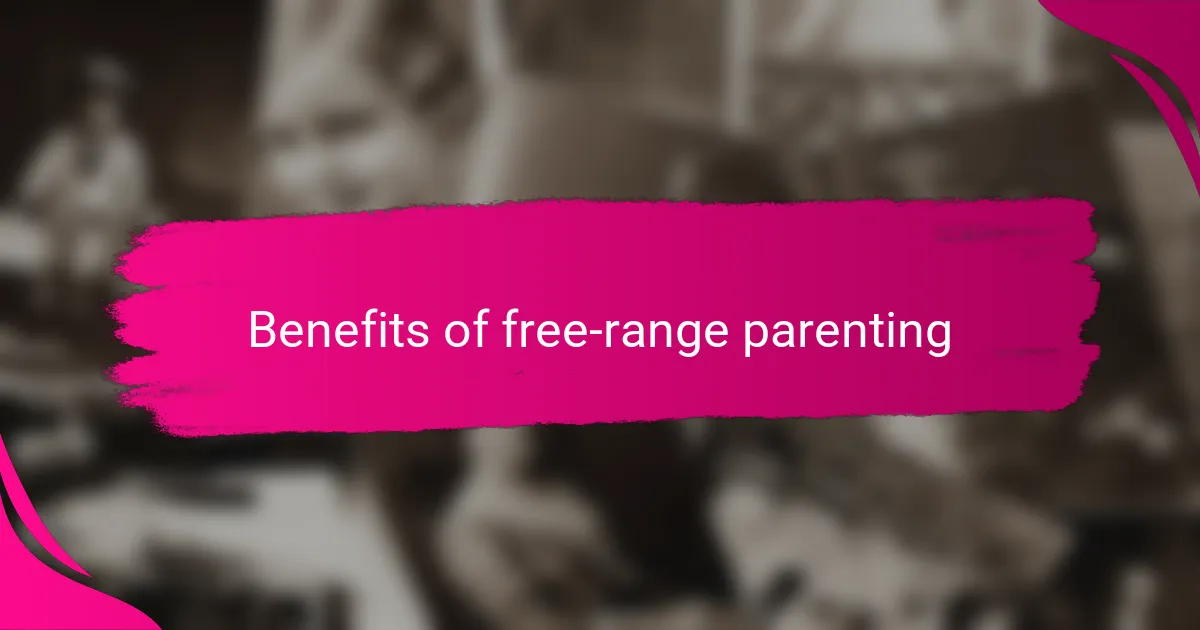
Benefits of free-range parenting
One of the biggest benefits I’ve witnessed with free-range parenting is how it naturally builds resilience. When my kids faced small challenges without me stepping in, they learned to bounce back on their own. Have you ever seen a child’s face light up after solving a tricky problem all by themselves? That moment of triumph is pure magic.
I also noticed that free-range parenting fostered better decision-making skills. By allowing my children to navigate choices within safe boundaries, they developed a stronger sense of responsibility. It’s rewarding to watch them consider options thoughtfully, knowing I’ve given them the freedom—and trust—to make those choices.
Most importantly, this approach deepened our relationship. Letting go enough to let them lead taught me to listen more and worry less. Isn’t it amazing how stepping back can sometimes bring you closer? It’s those quieter moments of mutual respect that made me believe in free-range parenting even more.
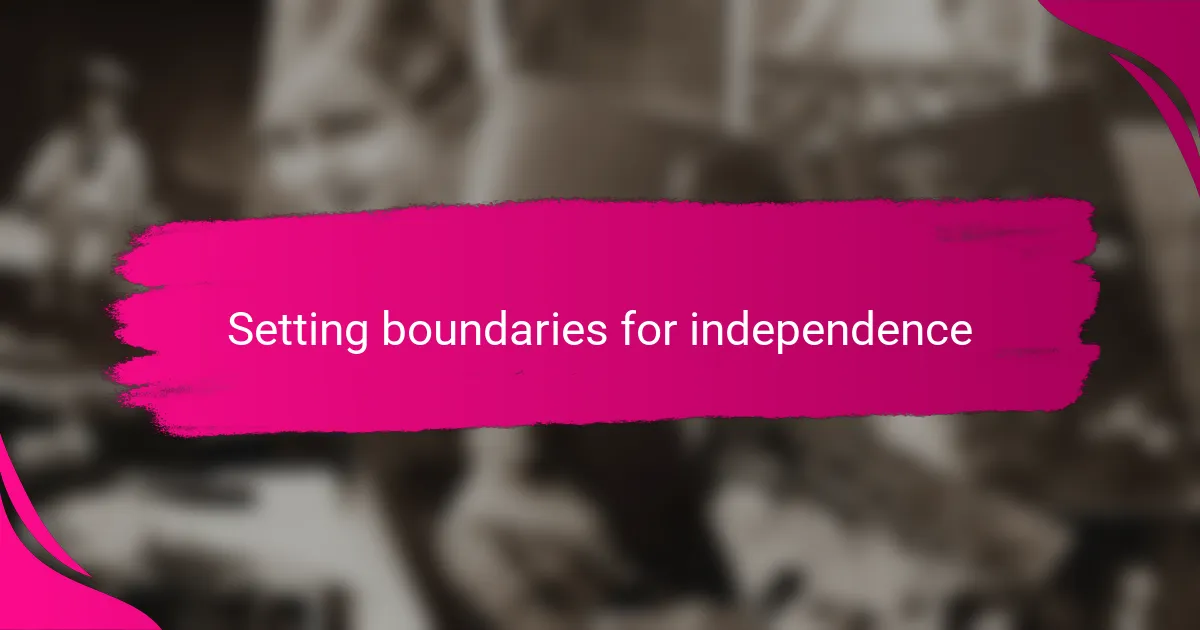
Setting boundaries for independence
Setting boundaries for independence is like drawing a safe perimeter around a playground where my kids can truly roam. I had to learn that clear limits don’t suffocate freedom—they actually guide it. Have you ever noticed how children feel more secure when they know exactly where the “off-limits” zones are?
At first, I struggled with defining these boundaries without making them feel like walls. But then I found that simple rules, like “check in every 15 minutes” or “don’t go beyond the park,” gave my kids a sense of freedom wrapped in safety. It’s amazing how those small guardrails encouraged them to explore boldly, yet responsibly.
Sometimes, I remind myself that setting boundaries isn’t about control—it’s about respect. By establishing clear expectations, I’m showing my children that their independence matters, but so does their well-being. Doesn’t that balance make the journey toward adulthood feel a little less daunting for both of us?
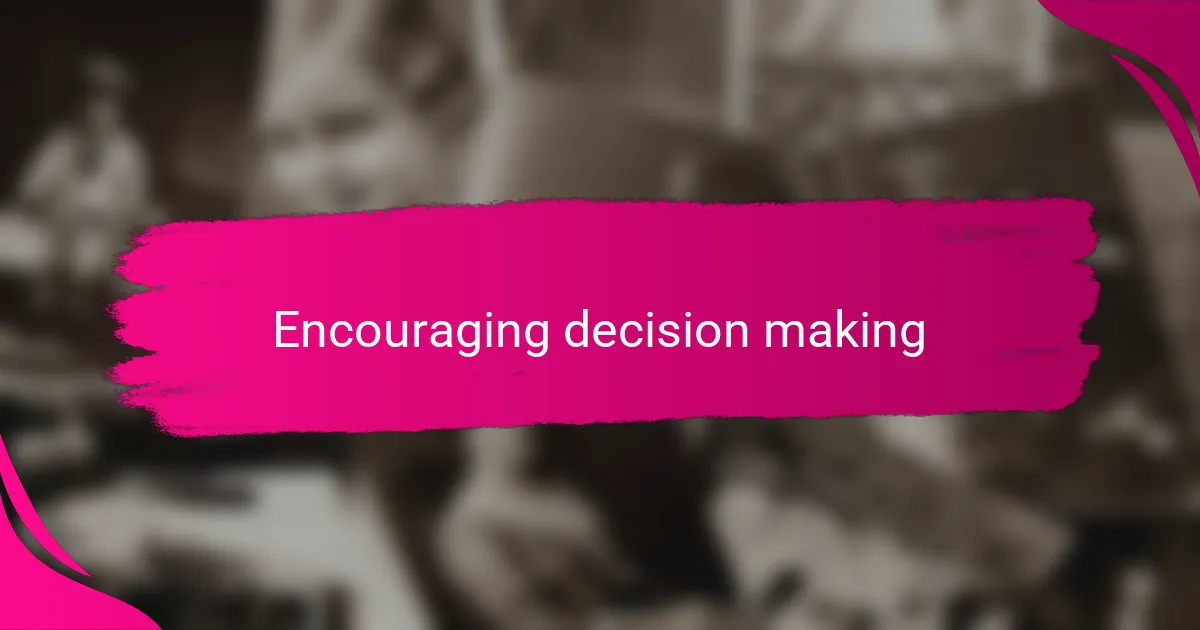
Encouraging decision making
Encouraging decision making means stepping back and letting my children weigh their options, even if I’m tempted to offer immediate advice. I remember a time when my son had to choose his own route home from a friend’s house; it felt risky, but watching him pull out his phone map and decide was a proud moment for both of us. Have you noticed how a simple choice, like picking what to wear or what snack to have, can become a valuable lesson in responsibility?
I found that giving my kids manageable decisions helps them build confidence gradually. Instead of dictating every step, I ask questions like, “What do you think would be the best choice here?” or “How do you plan to handle that?” This encourages thoughtful reflection and shows that their opinions truly matter. Isn’t it amazing how a little trust can transform hesitation into pride?
Sometimes, I remind myself that mistakes are part of the process and allow room for those too. When my daughter once chose to wear rain boots on a sunny day, I resisted correcting her immediately. Instead, I let her experience the choice’s consequence. She laughed about it later and made a different decision next time, and that small episode taught her far more than my words ever could. Doesn’t letting kids face these little bumps teach resilience in the kindest way?
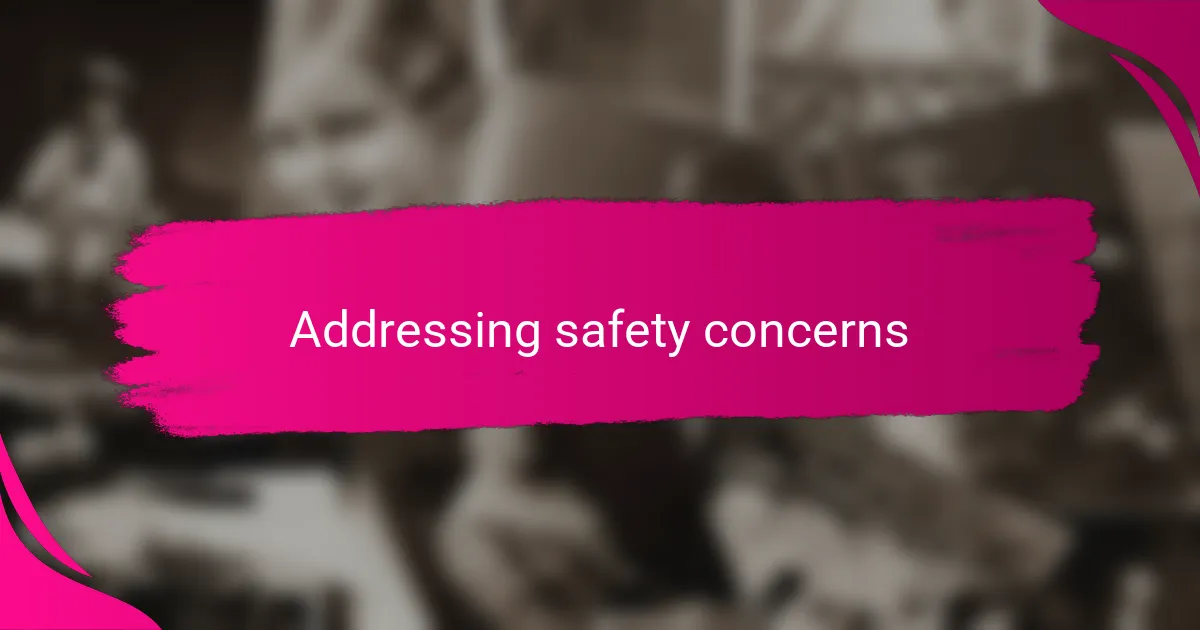
Addressing safety concerns
Safety concerns are the first hurdle many parents mention when I talk about free-range parenting. I won’t pretend it was easy to push past my own fears. But I began by carefully choosing safe environments—like quiet parks or familiar neighborhoods—where I could still keep an eye from a distance without hovering. Isn’t it surprising how much safer children are when parents relax just a little and trust their instincts too?
At one point, my neighbor voiced worries about letting kids walk a short distance alone. I shared how I teach my children “what-ifs” and simple safety rules, like knowing who to ask for help and always carrying a phone. That small safety net made both my kids and me feel ready to take those steps independently. Have you ever found that preparing kids with skills feels more empowering than restricting their every move?
Sometimes, I remind myself that safety isn’t about eliminating all risk—that’s impossible. Instead, I focus on minimizing dangers without stripping away freedom. By communicating openly with my children about hazards and encouraging them to trust their judgment, I’ve seen them develop that crucial balance between caution and confidence. Isn’t that what we all want for our kids—to be safe, yes, but also to learn to stand on their own?

Personal experiences and lessons
When my eldest confidently rode his bike to a nearby store for the first time alone, I felt a surge of pride mixed with a flicker of anxiety. It was a moment that taught me just how much trust and space my children need to truly grow independent. Have you ever experienced that heart-flip when you realize your child is ready to take a step without you?
I’ve learned that mistakes are often the best teachers. One afternoon, my daughter forgot her lunch at home and had to figure out how to manage at school—without me rushing to solve the problem. Watching her navigate that hiccup made me realize that not rescuing them every time lets children build real-life skills and confidence.
Over time, I noticed that stepping back also deepened our connection. When I stopped micromanaging and started listening more, the conversations became richer and more genuine. Have you found that giving your kids freedom sometimes opens the door to trust you didn’t know was there? That’s the beauty of this parenting approach.
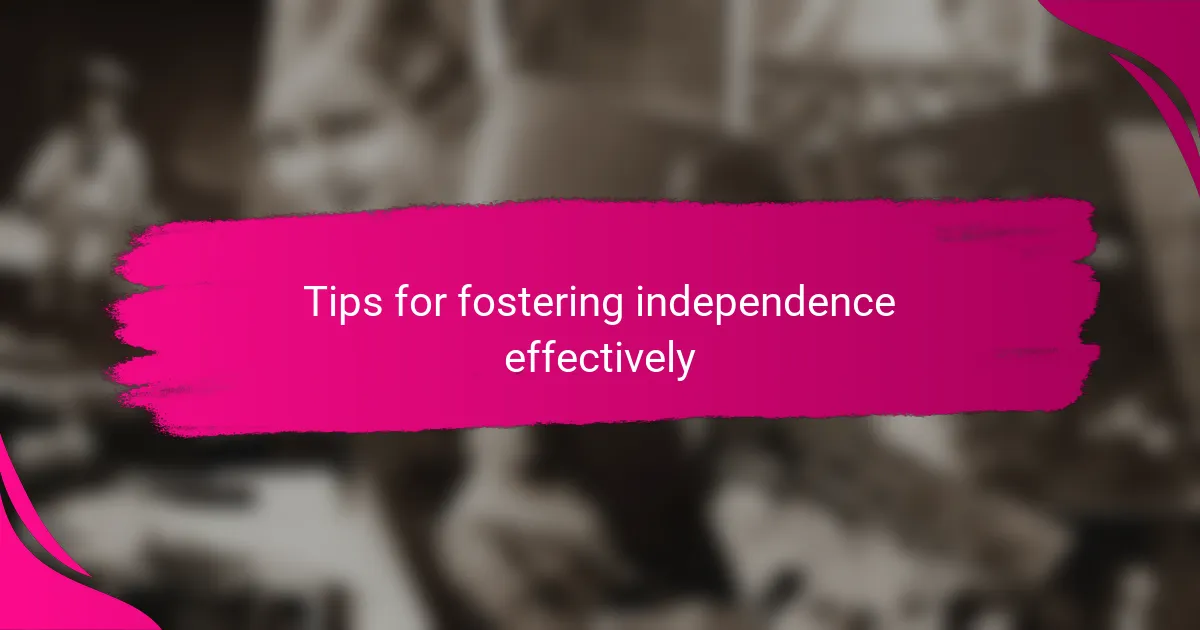
Tips for fostering independence effectively
One tip I find crucial is to start small with independence. Allowing kids to handle age-appropriate tasks, like packing their own school bag or choosing their clothes, builds confidence bit by bit. Have you noticed how these little wins create momentum and make bigger challenges seem less intimidating?
Another strategy that worked well for me is being patient and resisting the urge to fix every problem. When I let my children stumble a little, I see them develop problem-solving skills I hadn’t anticipated. It’s not always easy to watch them struggle, but isn’t it incredible how those moments teach resilience more than words ever could?
I also make it a point to celebrate their decisions, even when they don’t lead to perfect outcomes. Praising their efforts rather than just results encourages them to trust themselves. How often do we miss that chance to reinforce independence simply because we focus too much on the end result? From my experience, nurturing that trust is where true independence begins.
